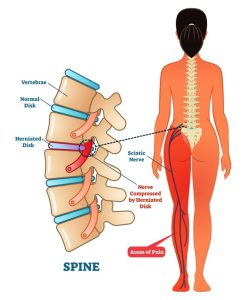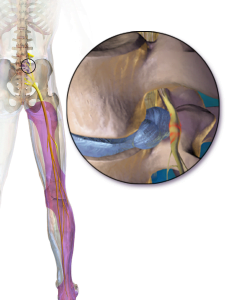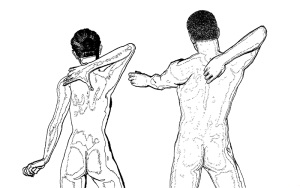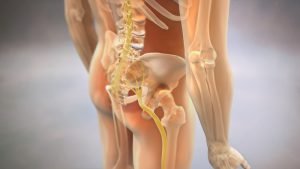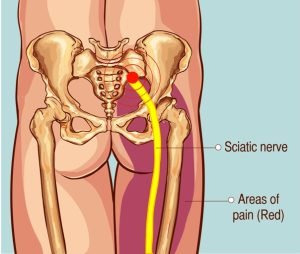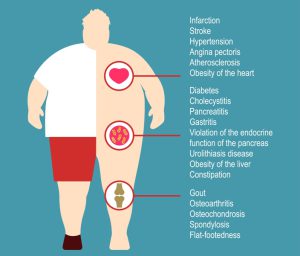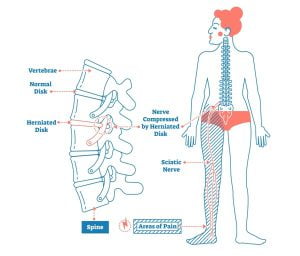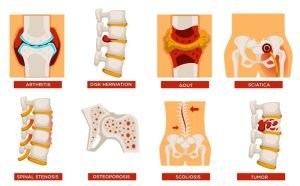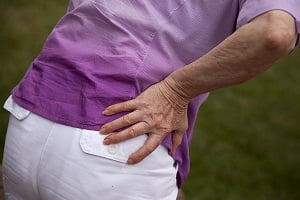Browsing: Sciatica Graphics
Comprehensive Information, Resources, and Support on Sciatica
Sciatica refers to back pain caused by a problem with the sciatic nerve. In women, wearing high heels can trigger sciatica. It is also estimated that about 60–80 percent of women who are pregnant are more likely to develop this problem due to increased pressure on the sciatic nerve from the developing uterus. During pregnancy, some hormones (such as relaxin) cause ligaments to loosen-up and stretch which results in back pain.
The sciatic nerve is the largest nerve in the body. Sciatica is the nerve pain which occurs due to irritation in the sciatic nerve. The pain may radiate down the back, outside, or front of the leg. Most cases of sciatica resolve by themselves within six weeks to three months. It is usually straightforward to diagnose.
The pain begins in the lower back, and radiates into the buttock and down the back of one leg. The pain is generally caused by the pressure exerted on the sciatic nerve from a herniated disc, bone spurs or muscle strain. Sciatica is generally a symptom of a ‘pinched nerve’ which affects one or more of the lower spinal nerves. Main causes of sciatica can be a herniated or slipped disc, piriformis syndrome, spinal stenosis, spondylolisthesis, etc. In some cases, the pain due to sciatica can be severe. For accurate diagnosis of cause of sciatica, X-rays and other tests, such as CT scan, MRI scan, and electromyogram, are used.
Most commonly, sciatica occurs when a herniated disk, degenerative disk disease, bone spur or overgrowth of bone on the spine or narrowing of the spine (spinal stenosis) compresses a part of the nerve. This means sciatica occurs due to pinched nerve. The sciatic nerve is one of the largest nerves in the body and it connects the spinal cord to the pelvis and legs. Sciatica pain depends on the location where the sciatic nerve is pinched. Sciatica pinched nerve leads to muscle weakness, numbness and shooting pain in the pelvis and legs.
The longest spinal nerve in the human body is the sciatic nerve. Sciatic nerve moves along the path – each side of the lower spine through the buttocks into the back of the thigh and all the way down to the foot. Any compression in the sciatic nerve due to herniated disk, bone spur on the spine or narrowing of the spine (spinal stenosis), etc leads to sciatica. Sciatica pain occurs in the lower back, muscles of buttocks to the entire lower leg, including the thigh, calf, ankle, and the back portion of the knee, sole of the foot, the ankle, etc. These areas might also suffer from some numbness, tingling, or a prickling sensation that radiates down the leg.
Being overweight is associated with back pain, including sciatica. Too much of body weight puts stress on your spine, which can cause spinal disorders that ultimately lead to sciatica and other back problems. It is commonly observed that patients of sciatica suffering from obesity take a longer time to heal than non-obese patients. Therefore, losing weight is beneficial for patients with sciatica.
Sciatica is a pain which originates in the sciatic nerve. The pain occurs in the lower back through the hips and buttocks and travels down each leg. Any pressure on the sciatic nerve (root) results in unilateral leg pain that radiates below the knee to the foot or toes. Risk factors associated with sciatica are increasing age, obesity, prolonged sitting, etc. The main cause of sciatica is nerve compression are herniated or slipped disk, lumbar spinal stenosis, any injury, tumor formation, etc. Exercise and maintaining correct posture helps prevent sciatica. Over the counter medicines and physical therapy are common treatments for it. Surgery is the last treatment option.
Spine disease is any impairment in the backbone. Some common spinal disorders are spinal stenosis, ankylosing spondylitis, spinal disc herniation, osteoarthritis, osteoporosis, scoliosis, sciatica, etc. One of the most common spine problems is sciatica. Sciatic pain occurs due to compression or pinching of the sciatic nerve. It affects the lower back, buttocks, and back of the leg. Sciatica can results in weakness in the affected leg, loss of bowel or bladder function, numbness, etc.
There are some remedies for back pain that treat sciatic nerve pain and improve your overall spine health. Treatment for sciatic pain involves, hot and cold packs, medicines, exercises and alternative remedies. In some people, sciatica pain can last a very long time despite trying various
ADVERTISEMENT




